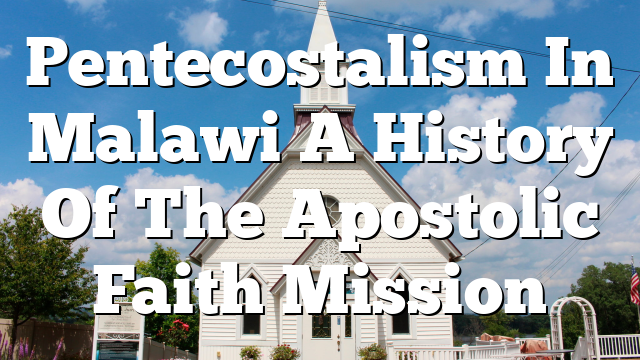Click to join the conversation with over 500,000 Pentecostal believers and scholars
Click to get our FREE MOBILE APP and stay connected
| PentecostalTheology.com



Book Reviews / Pneuma 33 (2011) 109-169
111
Ulf Strohbehn, Pentecostalism in Malawi: A History of the Apostolic Faith Mission, Kachere Teses 8 (Zomba, Malawi: Kachere, 2005). 203 pp.
Te story of Pentecostalism in Malawi is indicative of the global expansion of this vibrant spiritual movement over the past century. Presently, the small African nation of Malawi is estimated to have over 200 Pentecostal/Charismatic denominations and organizations, not withstanding that the first Pentecostal Church was not established until twenty-five years after the Azusa Street Revival in 1906. Te narrative of Pentecostalism in Malawi should be shared with the worldwide Pentecostal Church.
For this reason, the publication of Ulf Strohbehn’s research is a welcome contribution that provides a detailed historical account of the growth and development of the Apostolic Faith Mission (AFM), one of the earliest Pentecostal movements in this South-Central Afri- can nation. Te author traces the origins of the AFM in Malawi from its migrant labor beginnings through a period of missionary partnership to the formation of a small denom- ination that served as one of the major tributaries of Pentecostal exploits among the Mala- wian people. Strohbehn has a personal interest in this story. As an ordained minister of the German Pentecostal movement, he serves as a missionary in Malawi and has worked closely with the AFM over the years.
Te history of the AFM in Malawi spotlights a truly indigenous beginning for this move- ment in contrast to other Pentecostal denominations, such as the Full Gospel Church (later known as the Assemblies of God in Malawi), who were organized alongside the pioneer work of Western missionaries. Tough the AFM experienced a period of missionary control, the genesis of this movement was marked by indigenous workers who encountered the Pente- costal experience while working in migrant camps in South Africa, Zimbabwe, and Zam- bia. One by one they returned home to proclaim the message of the gospel of Jesus Christ through the power of the Holy Spirit with an emphasis on healing and deliverance. Strohbehn contends the historical evidence supports the AFM as the first Pentecostal movement in Malawi. Te author makes a compelling case that the “history and colourful array of Pentecostalism in Malawi and southern Africa is strongly interwoven with the AFM” (11) (though other Pentecostal historians in Malawi dispute this assertion). Te author divides Pentecostal denominations in Malawi into five groups according to their historical and theological features: 1) Machona: this represents the oldest Pentecostal churches in Malawi pioneered by Malawian migrant workers (machona); (2) Missionary- initiated; (3) Charismatic fellowships; (4) Independent Charismatic and Pentecostals move- ments; and (5) Zionist denominations (Zionists are rejected as unorthodox by Pentecostal denominations in Malawi).
From its inception, the AFM bore the marks of a Pentecostal movement — strongly Christocentric, emphasis on Holy Spirit baptism with the evidence of speaking in tongues, evangelistic courage and zeal, prophecy, healings, miracles, and lay leadership empower- ment (including women). Interestingly, one liturgical practice that differs from the other Pentecostal traditions in Malawi was the AFM mode of “three-fold” water baptisms. Te practice of immersing baptismal candidates three times reminded adherents of a strong commitment to a Trinitarian position.
© Koninklijke Brill NV, Leiden, 2011 DOI: 10.1163/157007411X554758
1
112
Book Reviews / Pneuma 33 (2011) 109-169
Despite the short missionary career of John G. Lake in South Africa, his Pentecostal fervency found its way into the hearts of the machona that led to AFM presence in Malawi. Te feet of migrant workers from Malawi carried Pentecostalism back to their native land without any assistance from South African or Western missionaries.
For the Church to develop numerically, the training of national pastors and lay leaders would be necessary. Te idea of theological training had been perceived by older generations in the AFM as a danger to spiritual fervency. Eventually, Western missionaries would assist the AFM in Malawi with training, but the end result was a shift to a paternalistic phase of missionary control over the governance of the movement. As the era of paternalism passed, the national leadership renewed hope of restoring the “apostolic identity” once modeled by the early migrant workers. Today, the AFM in Malawi represents a smaller denomination compared to other Pentecostal/Charismatic denominations. Nevertheless, the movement continues to demonstrate a remarkable commitment to its Pentecostal roots.
It is noteworthy that Strohbehn does not gloss over the failures of the AFM in Malawi. Te historical development of this Pentecostal movement includes earthy details represent- ing internal conflicts motivated by personal ambition, paternal-minded missionaries, and contextual challenges as Pentecostalism encountered traditional ideas, values, and behaviors steeped in an animistic worldview.
Strohbehn demonstrates that “the true Spirit of Pentecost is reconciliatory” (39). As witnessed in the book of Acts, and experienced at Azusa, the Pentecostal Spirit empowered the Pentecostal Church in Malawi for evangelistic outreach that bridged tribal, racial, and social barriers. Moreover, Pentecostalism served to meet the felt-needs of Malawians in a holistic way: spiritual, physical, and emotional. Te added dimension of power encounter provided inroads into the hearts and minds of the people who lived in fearful bondage to tormenting ancestral spirits believed to be demons. Pentecostalism in Malawi introduced a religion of power. As a result, scores of Malawians turned to Pentecostalism perceiving the relevancy of its message and experience for their daily lives.
I recommend this book to those interested in Pentecostalism and/or African Christianity for several reasons: (1) It promotes a sense of identity for Pentecostalism in Malawi by fill- ing the gap of Pentecostal historiography in this region of Africa (there is very little pub- lished germane to Pentecostalism in Malawi); (2) It provides a well-researched source for Pentecostals in Malawi to reflect on the embodiment of their theology as it developed throughout the last century into the new millennium; (3) It provides interesting anthropo- logical and sociological aspects, for example, of the Pentecostal encounter with Malawi Traditional Religion, relationships between religious leaders and political leaders in Malawi, and the interpersonal dynamics between western missionaries and Malawian pastors; and (4) It adds to the collective understanding about the nature of Pentecostalism in our global context, reminding Pentecostal Christians of their common heritage and the convictions regarding the preeminent role of the Holy Spirit in the life of the Church today.
Reviewed by John L. Easter
International Director, All Nations Teological Seminary, Lilongwe, Malawi PhD student, Assemblies of God Teological Seminary, Springfield, Missouri john.easter@agmd.org
2




Most Talked About Today